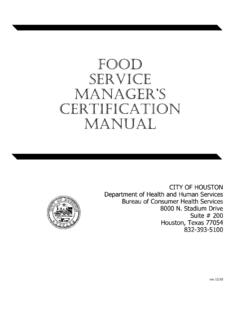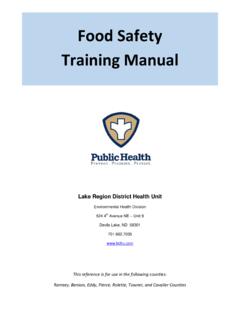Transcription of Preface - Centers for Disease Control and Prevention
1 Preface This report, which updates handbooks issued in 1969, 1973, and 1979, reviews the epidemiology of botulism in the United States since 1899, the problems of clinical and laboratory diagnosis, and the current concepts of treatment. It was written in response to a need for a comprehensive and current working manual for epidemiologists, clinicians, and laboratory workers. We acknowledge the contributions in the preparation of this review of past and present physicians, veterinarians, and staff of the foodborne and Diarrheal Diseases Branch, Division of Bacterial and Mycotic Diseases (DBMD), National center for Infectious Diseases (NCID). The excellent review of Drs. Meyer and B. Eddie, "Fifty Years of Botulism in the United States,"1 is the source of all statistical information for 1899-1949. Data for 1950-1996 are derived from outbreaks reported to CDC. Suggested citation Centers for Disease Control and Prevention : Botulism in the United States, 1899-1996. Handbook for Epidemiologists, Clinicians, and Laboratory Workers, Atlanta, GA.
2 Centers for Disease Control and Prevention , 1998. 1 Meyer KF, Eddie B. Fifty years of botulism in the and Canada. George Williams Hooper Foundation, University of California, San Francisco, 1950. 1 Dedication This handbook is dedicated to Dr. Charles Hatheway (1932-1998), who served as Chief of the National Botulism Surveillance and Reference Laboratory at CDC from 1975 to 1997. Dr. Hatheway devoted his professional life to the study of botulism; his depth of knowledge and scientific integrity were known worldwide. He was a true humanitarian and served as mentor and friend to countless epidemiologists, research scientists, students, and laboratory workers. 2 Table of contents Page Preface 1 I. Emergency assistance 4 II. Introduction 5 III. foodborne botulism 7 A.
3 Incidence 7 B. Morbidity and mortality 7 C. Geographic distribution 7 D. Food sources and products causing outbreaks 8 E. Prevention and Control 8 IV. Infant botulism 9 A. Epidemiology 9 B. Source of C. botulinum 10 C. Prevention and Control 10 V. Wound botulism 10 VI. Child or adult botulism from intestinal colonization 11 VII. Clinical syndrome 11 VIII. Diagnosis 12 IX. Treatment 13 X. Public health response 14 XI. Laboratory confirmation 15 A. Overview 15 B. Safety precautions 15 C. Collection of specimens 16 D. Shipment of specimens 17 E. Examination of specimens for botulinum toxin 17 F. Isolation of C. botulinum 19 XII. References 22 XIII. Selected references for further reading 25 XIV. Tables and figures 26 XV. Appendix 42 3 I. Emergency assistance Botulism is a public health emergency. Prompt diagnosis and early treatment of botulism are essential to minimize the otherwise great risk of death. Prompt epidemiologic investigation is critical to prevent further cases from occurring if a hazardous food is still available for consumption.
4 State health departments and the Centers for Disease Control and Prevention (CDC) offer 24-hour diagnostic consultation, epidemic assistance, and diagnostic laboratory services. Trivalent botulinum antitoxin (for Clostridium botulinum types A, B, and E) and bivalent botulinum antitoxin (for types A and B) is available from CDC. Health care providers who suspect they have a patient with botulism should contact their state health department epidemiology offices. The foodborne and Diarrheal Diseases Branch of CDC (FDDB/DBMD/NCID/CDC) can provide emergency consultation and support to public health authorities. foodborne and Diarrheal Diseases Branch Days phone (404) 639-2206 (Monday-Friday, 8:30 AM-4:30 PM, eastern time) Nights/weekends phone (404) 639-2888 Diagnostic laboratory services are available at several state public health laboratories and CDC. Names of manufacturers and trade names are provided for identification only, and inclusion does not imply endorsement by the Public Health Service or the Department of Health and Human Services.
5 4 II. Introduction Botulism is a neuroparalytic illness resulting from the action of a potent toxin produced by the organism Clostridium botulinum. This microbe was first described in 1897 by E. van Ermengem after his investigation of a foodborne outbreak in Ellezelles, Belgium. foodborne botulism is rare but it may kill rapidly, and contaminated products may expose many persons. foodborne botulism therefore, represents a medical and a public health emergency that places a premium on rapid, effective communication between clinicians and public health officials.(1,2) Botulism comes from the Latin botulus, meaning sausage. When botulism was first recognized in Europe, many cases were caused by home-fermented sausages. This derivation, although historically important, has lost much of its significance, since plant rather than animal products are more common vehicles. Sausage now is rarely the cause of botulism in the United States. Four distinct forms of botulism can occur, depending on the mode of acquisition of the toxin.
6 foodborne botulism results from the ingestion of food containing preformed toxin. Wound botulism is caused by organisms that multiply and produce toxin in a contaminated wound. Infant botulism is due to the endogenous production of toxin by germinating spores of C. botulinum in the intestine of the infant. Child or adult botulism from intestinal colonization is represented by those cases in which no food vehicle can be identified, there is no evidence of wound botulism, and there is the possibility of intestinal colonization in a person older than 1 year of age. C. botulinum is a group of culturally distinct organisms that are alike only in that they are clostridia and produce antigenically distinct neurotoxins with a similar pharmacologic action. C. botulinum organisms are straight to slightly curved, gram-positive (in young cultures), motile, anaerobic rods, m in width, m in length, with oval, subterminal spores. (3) The seven types of C. botulinum (A-G) are distinguished by the antigenic characteristics of the neurotoxins they produce.
7 Types A, B, E, and in rare cases, F cause Disease in humans. Types C and D cause Disease in birds and mammals. Type G, identified in 1970, has not yet been confirmed as a cause of illness in humans or animals. Important epidemiologic features and some clinical characteristics distinguish the types of botulism that cause human illness. Rare cases of infant and adult botulism have been confirmed to be the result of intestinal colonization by non botulinum Clostridium species that produced botulinum neurotoxin. The structure and mechanism of action of each of the seven neurotoxins are similar. Each toxigenic Clostridia produces a polypeptide of 150 kDa which is activated by proteases following bacterial lysis. The active toxin consists of a heavy chain (H, 100 kDa) and a light chain (L, 50 kDa). The heavy chain consists of an amino-terminal 50 kDa domain (HN) and a carboxy-terminal 50 kDa domain (HC). Neuronal cell intoxication occurs through four steps: (1) binding of HC to polysialoganglioside (and probably other protein) receptors on the neuronal membrane, (2) internalization of active toxin into endosomal-like compartments, (3) membrane translocation facilitated by HN, and (4) enzymatic cleavage of target proteins by the L chain to prevent the release of the neurotransmitter acetylcholine from synaptic terminals of the motorneurons in muscle.
8 The L chain of each neurotoxin type is a zinc-endopeptidase which has been shown to cleave a toxin-specific location of at least one of 3 proteins (VAMP, SNAP-25, or syntaxin). Although their absolute functions are unkown, these 3 proteins are members of a 5 group of proteins (SNARE proteins) which are essential to the docking and fusion of synaptic vesicles with the pre-synaptic membrane. The exact mechanism for neurotransmitter release is not known but most likely involves a fusion pore or a complete membrane fusion. Cleavage of one of the SNARE proteins by botulinum neurotoxin inhibits the release of acetylcholine from the synaptic terminal.(4) The ability of C. botulinum to cause food poisoning in humans is directly related to the production of heat-resistant spores that survive preservation methods that kill nonsporulating organisms .(5) The heat resistance of spores varies from type to type and even from strain to strain within each type; although some strains will not survive at 80EC, spores of many strains require temperatures above boiling to ensure destruction.
9 (6,7) The thermal resistance of spores also increases with higher pH and lower salt content of the medium in which the spores are suspended.(8) In many cases, it is impractical or undesirable to treat a food product in a manner to eliminate all C. botulinum spores. As a result, most Control methods focus on the inhibition of growth and toxin production. The main limiting factors for growth of C. botulinum in foods are: (1) temperature, (2) pH, (3) water activity, (4) redox potential, (5) food preservatives, and (6) competing microorganisms. All of these factors are interrelated and so changing one factor influences the effect of other factors. The interaction of factors may have a positive or negative effect on the inhibition of C. botulinum. In general, proteolytic strains grow optimally at 40 C; the lower limit is 10 C, upper limit is 45-50 C. Nonproteolytic strains, including type E can continue to grow even at C. The minimum pH range for growth of proteolytic strains is ; the limit is pH for nonproteolytic strains.
10 However, some food proteins, such as soy and beef, may have a protective effect on C. botulinum at or below pH In addition, certain food preparations may contain low-acid pockets in which the pH may be high enough to support the production of toxin. Low water activity (aw) inhibits the growth of C. botulinum. A minimum aw of ~ is needed to support growth and toxin production. Water activity can be limited by dehydration, but is in general controlled by the addition of NaCl. The minimum aw of corresponds to an approximate 10% NaCl solution. High redox potential (Eh) is usually due to the presence of O2. The optimum Eh for growth of C. botulinum is low (~-350 mV) but toxin production has been observed at Eh of +250 mV. Because of this range, C. botulinum growth and toxin production can occur even in products considered to have a high oxygen level. In addition, vacuum-packaging used to lower Eh to preserve food increases anaerobic conditions and so may support the production of toxin.














